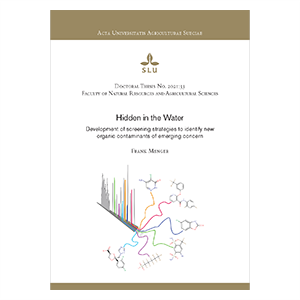Man-made chemicals enable and sustain our modern quality of life. However, these chemicals can, if released into nature, be harmful for plants, animals and humans. Many new chemicals have an unknown impact on ecosystems and human health. When found in nature, these pollutants are known as contaminants of emerging concern (CECs), highlighting the need for a better understanding of their effects and fate.
There is currently a considerable lag time between release of chemicals to the environment and their identification as CECs. In fact, many new pollutants may already be present in the environment. High-resolution mass spectrometry (HRMS, see fact box below) is currently the technique of choice to identify new CECs.
In a new doctoral thesis, Frank Menger, has looked at ways to reduce the time lag between release and detection by developing new screening strategies for identification of CECs using HRMS. First, information about existing strategies of using HRMS to identify unknown chemical pollutants was collected from scientific literature and knowledge gaps were discovered. Then, three field studies were performed to identify chemicals of potential concern in the environment and address some of the identified knowledge gaps.
Chemicals in River Fyris
In the first study, water samples from the river Fyris in Uppsala were collected and different halogen containing chemicals were identified. These chemicals are of concern because they tend to be persistent and tend to have toxic properties. Different wastewater treatment facilities were determined as potential sources of these newly identified pollutants.
Pesticides in agricultural streams
In the second study, which was performed in collaboration with the Swedish national monitoring program for pesticides, two agricultural streams were screened for unknown pesticide transformation products and several were identified. Concentrations were estimated for the newly identified pollutants. In some cases, transformation products were found at higher concentrations than the respective parent pesticides. This study also highlighted the advantages of collaborating across different sectors towards a common goal.
Pollutants in mussels
In the third study, zebra mussels were collected from Lake Mälaren and screened for different chemicals of interest, e.g. halogen containing chemicals and potentially water-borne chemicals accumulating in the mussels. The mussel samples were analysed on a new generation of HRMS instrument, which helped to reduce the complexity of the mussel samples and allowed the (likely) identification of several chemical pollutants, despite the challenges posed by screening for chemical pollutants in naturally complex biological samples.
Powerful tool for a healthy environment
The thesis contributes to our understanding of chemical pollution in the aquatic environment and shows that HRMS is a powerful tool that can help create a healthy environment and a sustainable future.
Dissertation and thesis
Frank Menger succesfully defended his thesis "Hidden in the Water : Development of screening strategies to identify new organic contaminants of emerging concern" on 11 June 2021. A video recording of the defence can be viewed online.
Read the thesis: Menger, Frank (2021). Hidden in the Water : Development of screening strategies to identify new organic contaminants of emerging concern. Diss. (sammanfattning/summary) Sveriges lantbruksuniv., Acta Universitatis Agriculturae Sueciae, 1652-6880. ISBN 978-91-7760-744-1. eISBN 978-91-7760-745-8
